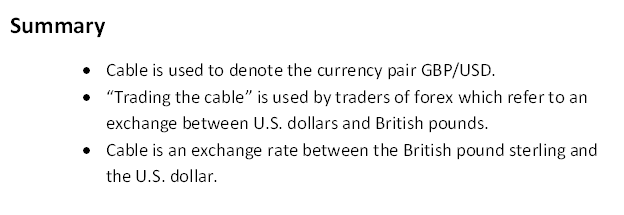What is Cable?
Cable refers to the informal or slang term that is used to denote the currency pair US dollar (USD) and Great Britain Pound (GBP). The term is mostly used by foreign exchange traders and is used as an exchange rate between the British pound sterling and the US dollar.

Source: Copyright © 2021 Kalkine Media Pty Ltd
Understanding Cable
Cable is quoted as GBP/USD, in this the British pound is the base currency and the U.S. dollar is the quote currency. It means GBP is trading against the US dollar.
The pair of other currencies such as euro in reference to the British pound is quoted as sterling/Euro (not cable). The British pound is quoted as GBP (currency code), which stands for Great Britain pound. Sometimes traders do use the term “trading the cable” in forex market.
There was a time when the pound was considered as the dominant currency, transactions between the pound and dollar happened through transatlantic cable. At that time, the traders were called cable dealers in forex.
Frequently Asked Questions (FAQs)
What is the history of cable?
Since the Anglo-Saxon era 775 AD, pound has been used as a currency. In 1800s after adopting by Germany, the sterling’s value started defining in official gold standard. In 1914 during the World War I, the British government forced to devalue its pound by 30%.
In 1925, British Prime Minister Winston Churchill decided to go back to the gold standard. After that in 1934, GBP value increased to its highest against the dollar. At this time, the US government was forced to decrease value of the dollar.
At the time of World War II, value of the GBP/USD decreased to newer lows. After the World War II, English economy struggled badly as the pound devalued twice against the USD.
In 1971, there was a turning point for the GBP, when the pound sterling entered in a floating exchange. By introducing it in the floating exchange rate regime, the GBP now had the permission to compete depending on its volume of trading and purchasing power with other different currencies.
In 1990s, the UK was struggling with the recession. For maintaining the value of the pound sterling against the German deutschmark, the Bank of England raised interest rates and bought large amounts of GBP.
On 16 September 1992, the UK left the ERM which resulted in 20% downfall in the pound value against the dollar in a single day. By March 2009, a quantitative programme was announced by the Bank of England, which stressed on cutting down the bank by 50 points and GBP/USD rate was 1.3971.
In June 2016, when Britain decided to vote out of the European Union, the currency pair GBP/USD devalued of $1.33 in 30 years. This caused fall in the value of pound in July 2016, the currency pair (GBP/USD) rate was $1.2885.
After 2016, internal political crisis of UK resulted in volatility in the prices of Cable. Due to uncertainty during the Brexit negotiations between the UK and EU, the cable slipped to the fourth position in the most traded currency pair category in the world. (SOURCE: https://blackwellglobal.com/the-history-of-cable/)
What is cable in foreign exchange?
In forex, the term cable is used for the currency pair of the British pound (GBP) and the U.S. dollar (USD). The term “trading the cable” is used by traders of forex which refer to an exchange between U.S. dollars and British pounds, and the term “cable” defines the exchange rate between the British pound and dollar.
In the mid-19th century, the word "trading the cable" has found when the transatlantic cable was used to telegraph international communications service. It is used to transmit the message across the Atlantic Ocean between New York and London. This idea came into picture in 1840 and attempted for the first in 1850s.
Since 1850s, the term cable has been used to refer the exchange rate between the GBP and the U.S. dollar. The currency pair GBP/USD (British pound/U.S. dollar) recorded as most traded currency pairs in the world.
The British pound is only called as cable when it pairs with the USD (US dollar), not with any other currency. (SOURCE: https://www.investopedia.com/ask/answers/09/trading-the-cable.asp)
Why cable is called as Dominant Currency?
When we are talking about currencies, the British pound (pound sterling) comes first in the mind because it is the oldest one, and is still considered as the most traded currency in the world. For centuries, it was known as the world's dominant currency. The pound was known as the world’s reserve currency, which means that other nations held their excess cash in the Pound.
In 1914 during the World War I when the inflation was at its peak, UK held off the gold standard in order to control its debt. The heavy debt on the British government from the United States resulted in the US dollar treated as reserve currency which was formally held by the pound. The pound was devalued by 30% in 1949.
By the beginning of 21st century, the dollar was the leading the reserve currency in the world. In 2019, currency pair (GBP/USD) recorded fourth place the world as the most traded currency pair. According to an International Monetary Fund (IMF) report, the pound will take a place on the fifth number of the most traded currency pair at the completion of 2020. (SOURCE: https://www.investopedia.com/terms/c/cable.asp#:~:text=Cable%20is%20a%20slang%20term,to%20the%20British%20pound%20sterling.)
 Please wait processing your request...
Please wait processing your request...